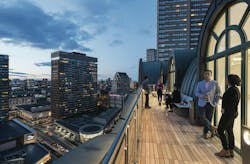Creating real estate value with commercial office reconstruction [AIA course]
The commercial office sector shows few signs of slowing down. According to a 2017 end-of-year survey from real estate firm Transwestern, fourth-quarter vacancy rates in the U.S. landed at 11.5%, the lowest in 10 years, even as average asking rents continue to rise.
As leading market drivers like the so-called TAMI sector—technology, advertising, media, and information—push demand for differentiated, amenity-centric, and tenant-focused office product, one might think that older buildings are at a disadvantage. Savvy Building Teams say that’s not always the case.
In fact, from San Francisco to Boston, from New York to Chicago, leading owners, developers, and project teams are employing thoughtful upgrades to older buildings to create meaningful spaces that help attract and retain top tenants—and their best people.
Six common strategies used by these Building Teams help address competitive pressures and deliver more attractive offerings with renovated and reconstructed commercial developments.
LEARNING OBJECTIVES
After reading this article, you should be able to:
• Describe how market dynamics and local codes are changing the needs for adaptive-reuse projects.
• Understand office building end-user preferences for amenities.
• List the factors in planning upgrades of older buildings and historic landmarks.
• Discuss approaches to improving existing office buildings that leverage technology and reduce energy use.
